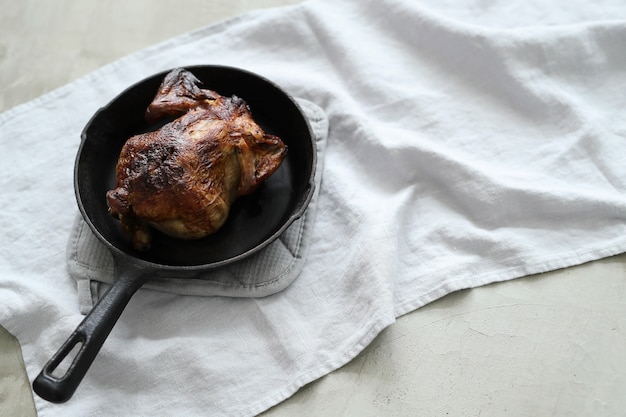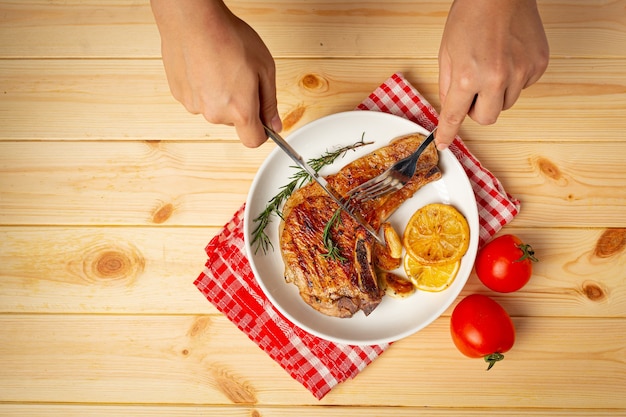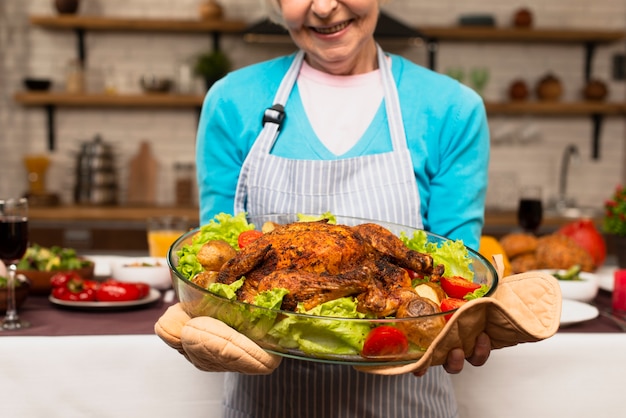Confession time: I've been a chicken enthusiast for as long as I can remember. It's so versatile, it's so easy to cook, and it's undeniably delicious. But for years, I struggled to get that perfect, juicy, and tender chicken every single time. Sometimes it would be dry as a bone, other times it would be undercooked, and even the occasional burnt offering would sneak its way into the mix. It was enough to make me question my culinary abilities, honestly!
But then, I decided to take a deep dive into the world of chicken cooking. I delved into cookbooks, watched countless YouTube videos, and even consulted with my gran, who's got a lifetime of kitchen wisdom under her apron. Slowly but surely, I started to crack the code of the perfect skillet chicken. And let me tell you, it's a game-changer! Now, I can confidently whip up a mouthwatering chicken dinner that leaves everyone wanting more.
So, if you're looking to level up your chicken game and finally say goodbye to dry, overcooked, or undercooked disasters, you've come to the right place. This is your ultimate guide to mastering skillet chicken, from choosing the right pan to achieving that perfect sear, all while understanding the science behind it. Get ready to become a chicken cooking superstar!
(Part 1) The Basics: Choosing the Right Pan and Chicken

Before we even start cooking, it's crucial to set the foundation – choosing the right tools for the job. A good pan and the right cut of chicken are essential for a successful dish.
The Perfect Pan
There's a whole world of pans out there, but when it comes to cooking chicken in a skillet, a few key factors stand out:
- Material: Cast iron is a classic choice for a reason. It heats evenly and retains heat beautifully, ensuring your chicken gets that perfect crust. Plus, with proper care, it can last for generations. However, if you're new to cast iron, it can be a bit intimidating. Don't worry, a good quality stainless steel skillet will also do the trick. Just make sure it has a heavy base to prevent warping.
- Size: Don't crowd your pan! You want to ensure that the chicken has enough space to cook evenly. A 10-12 inch skillet is generally perfect for a couple of chicken breasts or thighs.
- Handle: A sturdy, comfortable handle is key for maneuvering your pan and preventing any accidental spills. Make sure your pan's handle is long enough and not too thin.
The Chicken Star
Now, let's talk about the main attraction: the chicken! While all types of chicken can be cooked in a skillet, certain cuts are better suited for this method. Here's what I recommend:
- Boneless, Skin-on Chicken Breasts: These are a popular choice for skillet cooking because they cook relatively quickly and evenly. Plus, the skin adds flavour and helps keep the breast juicy.
- chicken thighs: The dark meat in thighs tends to be more flavorful and forgiving, especially when it comes to overcooking. They also stay moister than breasts, making them a great choice for a beginner.
- chicken cutlets: These thin slices of breast or thigh are a great option for a quick meal. They cook fast and are perfect for stir-fries or paninis.
(Part 2) Getting That Perfect Sear: The Secret to juicy chicken

Alright, so you've got your pan and your chicken. Now, let's talk about the most important part of the process: the sear. This is where we create that beautiful golden-brown crust and lock in those delicious juices.
The Science of Searing
A good sear isn't just about aesthetics. It's all about the science of the Maillard reaction. When you apply high heat to the surface of the chicken, the sugars and amino acids react to create a symphony of flavour compounds. This is what gives your chicken that irresistible crispy exterior and rich, complex flavour.
The Art of the Sear
Here's how I do it:
- Pat It Dry: The first step is to pat the chicken dry with paper towels. Any moisture will prevent a nice sear from forming.
- Hot Pan, Cold Chicken: Always start with a super hot pan. Preheat it over medium-high heat for about 5 minutes. Then, add your chicken. Remember, you want a screaming hot pan, but a cold chicken. This helps ensure the chicken sears properly without overcooking the inside.
- Don't Move It!: Resist the urge to touch the chicken for at least 3-4 minutes. This gives the bottom time to develop that gorgeous crust. Once it's nicely browned, gently flip it over and cook the other side for another 3-4 minutes.
- Time for the Extras: Once the chicken has a nice sear on both sides, you can add your veggies, herbs, or any other additions. If you're making a sauce, you can add it now too.
(Part 3) Mastering the Chicken cooking times

Now, we're getting into the heart of the matter (pun intended!) – cooking times. Remember, these are just guidelines. Every stove and oven is different, so it's crucial to use a meat thermometer for the most accurate results.
chicken breast cook times
Boneless, skin-on chicken breasts are generally cooked to an internal temperature of 165°F (74°C). Here's a general guide:
| Thickness (inches) | Cooking Time (Minutes) |
|---|---|
| 1/2 | 5-7 |
| 3/4 | 7-9 |
| 1 | 9-11 |
Keep in mind that thicker breasts will take longer. Always err on the side of caution and check the internal temperature with a thermometer.
Chicken Thigh Cook Times
Chicken thighs are a little more forgiving when it comes to cooking time. Aim for an internal temperature of 165°F (74°C) as well.
| Thickness (inches) | Cooking Time (Minutes) |
|---|---|
| 1/2 | 8-10 |
| 3/4 | 10-12 |
| 1 | 12-15 |
Chicken Cutlet Cook Times
These little beauties cook up in a flash. Aim for 3-5 minutes per side, or until cooked through.
(Part 4) Chicken's Best Friends: Flavour Boosters and Sauce-Making
Alright, the chicken is cooking, but we don't want it to be a solo act! Let's spice things up with some flavourful additions that will take your chicken to the next level.
Seasoning Savvy
Don't just stick to plain salt and pepper! Get creative with your spices and herbs. Here are some of my favourites:
- Italian Flair: Oregano, thyme, basil, garlic powder, and red pepper flakes.
- Mediterranean Magic: Paprika, cumin, coriander, turmeric, and lemon zest.
- Asian Inspiration: Ginger, garlic, soy sauce, sesame oil, and chili flakes.
- Southern Comfort: Paprika, cayenne pepper, garlic powder, onion powder, and smoked paprika.
The Sauce-Making Symphony
Once your chicken is cooked, it's time to elevate the dish with a delicious sauce. Here are a few ideas:
- Creamy Lemon Sauce: Simply whisk together some heavy cream, lemon juice, salt, pepper, and a little Parmesan cheese.
- Spicy Tomato Sauce: Sauté some garlic, onions, and chopped tomatoes with a pinch of red pepper flakes and a touch of sugar for sweetness.
- Mushroom Gravy: Sauté sliced mushrooms with onions, garlic, and herbs. Deglaze the pan with white wine or broth and thicken with a cornstarch slurry.
- Garlic Herb Butter Sauce: Melt butter in the pan after removing the chicken. Add minced garlic, chopped herbs, and a squeeze of lemon juice. Spoon over the chicken.
- Honey Mustard Sauce: Whisk together Dijon mustard, honey, apple cider vinegar, and a pinch of salt and pepper. Drizzle over the chicken.
(Part 5) The Finishing Touch: Resting for Juicy Perfection
We're almost there! The chicken is cooked, the sauce is ready, but before you dive in, there's one more crucial step: resting. Just like a marathon runner needs a breather, your chicken needs a few minutes to relax and redistribute those juices.
Why Resting is Crucial
When you cook chicken, the juices get pushed towards the center of the meat. By resting the chicken, you allow these juices to redistribute evenly, resulting in a more tender and juicy outcome. Think of it as letting the chicken breathe and recover from its "workout" in the pan. This is a crucial step for achieving that perfect, tender, and juicy chicken.
Resting Time
A general rule of thumb is to let the chicken rest for 5-10 minutes before slicing and serving. This gives the juices time to settle back into the meat, ensuring a flavorful and tender bite. Cover it loosely with foil to keep it warm and prevent it from drying out.
(Part 6) Beyond the Basics: Variations and Experimentation
Now that you've mastered the fundamentals of skillet chicken, it's time to unleash your inner chef and experiment with different flavour combinations and techniques. The possibilities are endless!
Spice Up Your Routine
Get adventurous with your seasonings. Try adding citrus zest, chopped fresh herbs, or even a sprinkle of smoked paprika for a smoky flavour. You could even create a simple rub by combining a few spices, like garlic powder, onion powder, paprika, and cumin.
Veggies in the Mix
Don't limit yourself to just chicken. Add some colourful veggies to your skillet for a complete and satisfying meal. Some delicious pairings include:
- Sweet and Savoury: Carrots, sweet potatoes, bell peppers, and onions.
- Earthy Delights: Mushrooms, zucchini, and asparagus.
- Green Goodness: Broccoli, green beans, and spinach.
Beyond the Skillet
The skillet is your canvas, but don't be afraid to experiment with different cooking methods. After searing the chicken, you could transfer it to the oven for a final finish. Or, try a combination of stovetop and grill for a smoky char.
(Part 7) Troubleshooting: Common Chicken Cooking Challenges
Even the most seasoned cooks encounter challenges in the kitchen. But don't worry! Here are some common chicken cooking problems and their solutions:
1. Dry Chicken
The Problem: This is a classic chicken cooking mistake. Overcooked chicken loses its moisture, resulting in a dry, disappointing texture.
The Solution: Use a meat thermometer to ensure the chicken is cooked to the right temperature. Remember, resting the chicken is also crucial for retaining moisture. If you're still finding your chicken is dry, consider using a bone-in breast or thigh, as they tend to retain moisture better. You could also try adding a tablespoon or two of broth or water to the pan during the last few minutes of cooking, which helps steam the chicken and create a more moist environment.
2. undercooked chicken
The Problem: Undercooked chicken poses a food safety risk. It's crucial to cook chicken to the proper internal temperature of 165°F (74°C).
The Solution: Always use a meat thermometer to check the internal temperature of your chicken. Don't rely solely on visual cues. If the chicken isn't cooked through, return it to the heat and continue cooking until it reaches the safe temperature.
3. Burnt Chicken
The Problem: High heat can lead to burnt chicken, especially if you're not paying attention.
The Solution: Reduce the heat if you notice the chicken browning too quickly. Monitor the chicken closely and adjust the heat as needed. If you're prone to burning, consider cooking the chicken over medium heat instead of medium-high. This will take a little longer, but will help prevent burning.
4. Unevenly Cooked Chicken
The Problem: If your chicken is unevenly cooked, it might be due to overcrowding the pan or using inconsistent heat.
The Solution: Make sure you have enough space in your pan for the chicken to cook evenly. Avoid overcrowding the pan. If you need to cook a lot of chicken, cook it in batches. Also, ensure your heat is consistent by using a diffuser on your stovetop or checking the temperature of your pan periodically.
(Part 8) FAQs: Your Skillet Chicken Questions Answered
Here are some frequently asked questions that will help you become a chicken cooking pro.
1. What is the Best Temperature for Cooking Chicken in a Skillet?
The ideal temperature for searing chicken in a skillet is medium-high heat. Preheat your pan for about 5 minutes before adding the chicken. This allows the pan to heat up properly and create a nice, crispy crust. If you're using a cast iron pan, it will take a little longer to heat up. Be patient and let the pan get really hot before adding the chicken. You can test if the pan is hot enough by flicking a few drops of water on it. If they sizzle and evaporate quickly, it's ready. You can also check the temperature of your pan with a digital thermometer, aiming for around 400°F (200°C).
2. How Do I Know When Chicken is Done Cooking?
The most accurate way to determine if your chicken is cooked through is to use a meat thermometer. The chicken is safe to eat when it reaches an internal temperature of 165°F (74°C). You can also use visual cues. The chicken should be no longer pink, and the juices should run clear when you poke it with a fork. However, visual cues can be deceptive, so relying on a meat thermometer is always the best option.
3. Can I Use a Non-Stick Skillet to Cook Chicken?
Yes, you can use a non-stick skillet to cook chicken. However, the downside is that it won't create the same crispy, golden-brown crust that you get with a cast iron or stainless steel pan. If you're using a non-stick skillet, make sure you don't overcrowd the pan, as this can prevent the chicken from cooking evenly. Also, be careful not to use high heat with a non-stick skillet, as it can damage the coating.
4. What Should I Do With the Leftover Chicken?
Leftover chicken is a culinary goldmine! You can use it in a variety of dishes, such as salads, sandwiches, wraps, or soups. You can also shred it and use it in chicken enchiladas or chicken tacos. Just make sure to store the leftover chicken in the refrigerator within 2 hours of cooking and consume it within 3-4 days.
5. Is it Okay to Marinate Chicken Before Cooking?
Yes, marinating chicken before cooking is a great way to add flavour and tenderness. You can marinate chicken in anything from a simple mixture of olive oil, lemon juice, and herbs, to a more complex marinade with soy sauce, ginger, and garlic. Just make sure to marinate the chicken in the refrigerator for at least 30 minutes, or up to overnight for best results. Marinating helps tenderize the chicken, adds flavor, and creates a more flavorful crust. It also prevents the chicken from drying out. Just remember to pat the chicken dry before searing it.
And that's it, folks! You've got all the tools and knowledge you need to conquer the world of skillet chicken. Now, go forth and create some culinary masterpieces. Happy cooking!
Everyone is watching

Perfect Rice Every Time: The Ultimate Guide to Cooking Rice
Cooking TipsAs a self-proclaimed foodie, I've always been a bit obsessed with rice. It's the foundation of countless cuisi...

Prime Rib Roast Cooking Time Chart: Per Pound Guide
Cooking TipsPrime rib roast. Just the name conjures images of lavish dinners, crackling fires, and hearty laughter. It’s ...

The Ultimate Guide to Cooking Asparagus: Tips, Techniques, and Recipes
Cooking TipsAsparagus. The mere mention of this spring delicacy conjures up images of vibrant green spears, crisp and burs...

Ultimate Guide to Cooking the Perfect Thanksgiving Turkey
Cooking TipsThanksgiving. Just the word conjures up images of overflowing tables laden with delicious food, the scent of r...

How Long to Bake Potatoes in the Oven (Perfect Every Time)
Cooking TipsBaked potatoes are a staple in my kitchen. They're incredibly versatile, delicious, and surprisingly easy to m...
